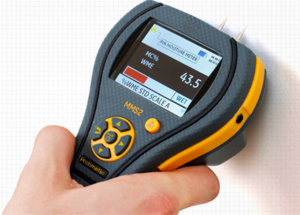Diagnosing Damp Services 
Call: 0800 2465668, or Get in Touch: HERE
Diagnosing damp using a speedy calcium carbide meter, to undertake an in-depth damp test to determine rising dampness & total moisture content in walls.
A speedy calcium carbide damp test is a method used for diagnosing damp by damp specialists to determine the moisture content within damp walls in houses. This damp test procedure aids our surveyors when investigating a property for damp and helps to determine an accurate diagnosis of the dampness within a property. A speedy carbide test has a greater degree of accuracy when compared to a Protimeter that also determines the moisture levels within a damp wall. Unlike the Protimeter moisture meter the speedy carbide test is a destructive method used to test walls and requires a sample of masonry from the wall or floor. As a result a Speedy Carbide Test tends to be only carried out if it is specifically requested by the owner of the property requiring an in-depth moisture analysis of masonry & plaster. This is normally following a flood / leaking appliances. It is particularly useful when some unscrupulous insurance companies insist that the problem has been caused by rising damp (for which your insurance policy does not cover) and are refusing to pay out a claim for water damage to your property, unless you can prove otherwise. This is when the speedy moisture test apparatus comes in….the point at when we need to use the calcium carbide method to accurately determine moisture content & provide you with an impartial independent damp report and recommendations for any repairs to your house.
Speedy carbide testing is carried out by moisture testing companies in order to diagnose the presence of damp following inconclusive results or when previous findings by chartered building surveyors & damp proofing companies have conflicting results. There are several reasons why moisture meters can show high damp readings on the surface of a wall when diagnosing damp, which may include rising damp, penetrating damp, salt contamination, condensation and plumbing leaks etc. This is why a house survey including this type of damp testing procedure must be carried out in conjunction with an external survey of the affected area to inspect for raised ground levels and any other sources of water ingress. The cause can also be determined from visual signs of damp showing internally and moisture patterns. Different causes of damp require varying treatments ranging widely in the amount of disruption and costs so the cause must be diagnosed correctly. Whilst in most cases the meter testing of walls and skirting boards and the recording of moisture profiles, together with internal and external house surveys would bring you to the correct conclusion, the use of a speedy calcium carbide test would help in the diagnosis for any rising damp investigations.
This damp testing apparatus itself contains a sealed vessel that is thoroughly cleaned before each calcium carbide test is carried out; this prevents any discrepancies with the results and provides an accurate reading. A specialist damp surveyor will then drill a hole in the affected wall to obtain a measured sample of brick dust or plaster to test the moisture content.
Materials used in building construction do however differ in porosity and their ability to hold moisture, therefore it is not possible to take comparative readings using a calcium carbide meter from different materials. The BRE states in digest 245 “if moisture content (MC) is less than 5% at the base, it is unlikely that the wall structure is severely affected by rising damp” This 5% figure is merely a guide and refers to the base of the wall above damp proof course level. It does not suggest readings recorded above 5% are indicative of rising damp, it states the importance of testing HMC and MC, as some materials when contaminated with salt can be above 5% MC even when in a dry state. Moisture content readings from within the structure of the wall can be obtained in a few minutes.
Actual moisture content is determined rather than the Wood Moisture Equivalent (WME) readings displayed on a moisture meter. After testing samples, the cost of accurate diagnosis usually results in avoiding unnecessary cost on very disruptive chemically injected damp-proof course work, which usually results after obtaining unqualified advice from surveyors recording or reporting “evidence” of rising / penetrating dampness using inappropriate and misleading diagnostic damp testing methods.
“Diagnosing rising dampness in buildings needs careful and systematic thought because it can easily be confused with penetrating damp and condensation. The Building Research Establishment (BRE) have suggested that only 10% of the dampness problems it investigates are attributable to rising damp. Unfortunately, there are a number of damp-proofing companies specialising in d.p.c. replacement who obviously have a commercial interest in finding problems with rising damp.
The diagnosis of dampness needs to be treated with caution. Although there are several reputable damp companies working in this field, it may be wise to seek independent damp advice. Further “encouragement” to find problems of rising damp is provided by banks and building societies who often request a damp report as a condition of a mortgage advance, after high damp meter readings have been identified following a homebuyers survey.
“Investigations have revealed many instances in which damp-proofing systems intended to combat rising dampness have been installed in buildings where rising damp is not occurring, and where moisture meter readings found during a home inspection are at acceptable levels. A frequent reason for this has been a wrong interpretation of high readings obtained by using an electrical moisture meter”. Another reason is the failure to recognize other causes of damp conditions or the incorrect interpretation of results and analysis.
Property surveyors, who carry out home inspections for building societies and homeowners, will check walls for dampness using an electrical conductance damp testing meter most commonly manufactured by “Protimeter”. The electrical resistance damp testing meter assesses the level of moisture content in timber, this was the task it was designed for! In skilled hands, it can be used to determine the presence of moisture in other materials. However, it can only record the presence of surface moisture and is unable to determine the true moisture content existing in the underlying structural brickwork.
Diagnosing damp & timber decay problems – what signs to look for
The first step in fixing dampness is to find the main source. There are many different types of dampness – here are the signs you should be looking out for.
RISING DAMP
Rising damp is caused by a non-existent or faulty damp proof course and describes the action of groundwater moving up through a wall through capillary action. Due to the nature of rising damp, only your ground floor will be affected by this type of damp. Signs of rising damp include:
- A noticeable tidemark on an interior wall up to 1.5m
- Peeling or flaking skirting boards
- Blistering plaster or paint
- White powder on walls (salts)
PENERTRATING DAMPNESS
Penetrating damp, otherwise referred to as water ingress, means that water is making its way into your home from the outside. This can occur in a number of ways, either via a burst pipe, leaky roof, or damaged masonry. Common signs of penetrating damp include:
- Localised damp patches on walls or ceiling
- Damp that becomes more visible when it rains
- Moss or algae growth on external wall
- Damaged brickwork
- Damaged guttering and down pipes
CONDENSATION
Condensation is caused by poor ventilation and is the most common type of damp to affect UK homes. Condensation mostly occurring during the winter when the difference between external and internal temperatures is most dramatic. Signs of condensation problem include:
- Fogging on windows
- Black mould growth on windowsills, walls or even furniture
- Smell of mildew
- Blistering paint
- Peeling wallpaper
TIMBER ROT
It is important to catch timber rot before it has time to develop. Dry rot in particular spreads very easily throughout a property and weakens rafters and floorboards over time, to the point that they will eventually become unsafe. Dry rot and wet rot affect your timbers in different ways:
DRY ROT
- Damp, fungal mushroom smell
- Affected timber feels brittle and warped
- Deep cracks in the wood – often in a ‘cube’ formation
- Evidence of mycelium growth on timbers (white fluffy coating)
- Large fruiting bodies
WET ROT
- Affected timber feels wet and spongy
- Affected timber will appear darker
- Easy to crumble
- Damp, musty odour
- Look out for black fungus growth
Contact our independent timber and damp experts today!
If you have already identified your damp problem, great! Our independent damp experts can offer environmentally friendly cost effective damp solutions. If you need further help with identifying the cause of damp in your home, then we can carry out a professional damp survey to provide the answers you need to get started on repairs.
P. Thomas C.T.I.S., C.S.R.T., MIWSc. Call Direct 0800 246 56 68 Alternatively to arrange a survey please fill in our contact form
